UI Professor Listens to Echoes of Iowa’s Past in Historic Barn
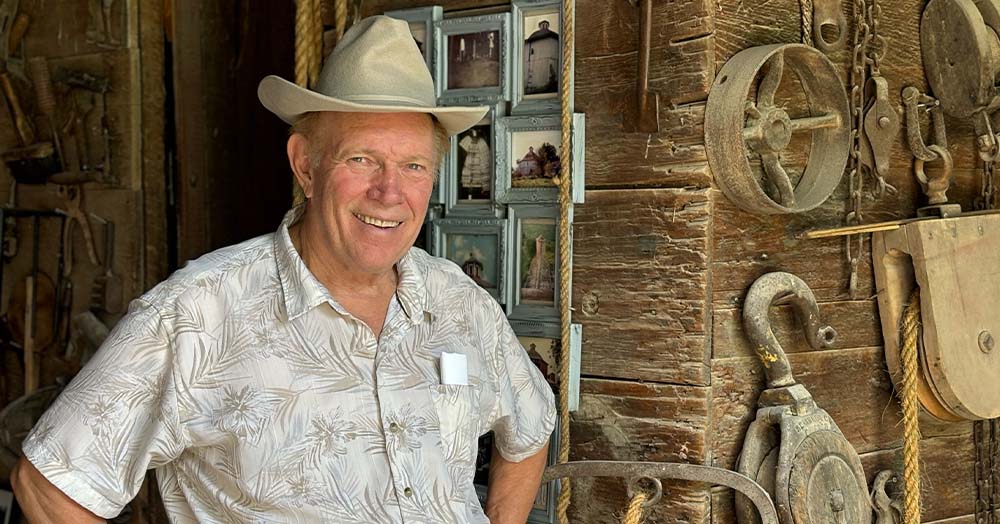 PHOTO: JOSH O'LEARY
UI professor Richard Tyler is pictured inside the historic Secrest Barn in rural Johnson County.
PHOTO: JOSH O'LEARY
UI professor Richard Tyler is pictured inside the historic Secrest Barn in rural Johnson County.
When University of Iowa professor Richard Tyler (78PhD) first stepped into the Secrest Octagonal Barn, it was hard to imagine it had once been considered an architectural wonder. The abandoned 19th century farm building—on an acreage Tyler purchased in 1992 on a gravel road a few miles east of Iowa City—was filled with rotting hay, mud-caked rooms, and walls buckling under a porous roof.
Instead of accepting the barn’s inevitable decay, Tyler saw something worth preserving. An accomplished audiologist at UI Health Care and the Carver College of Medicine, Tyler has spent the past three decades amplifying the echoes of Iowa’s agricultural history in one of the state’s most distinctive barns.
“I didn’t have any farming background, but I was always interested in architecture, and this turned out to be a special place,” says the professor of otolaryngology and communication sciences. “It was a mess, but it was incredibly unique. There’s no barn like this anywhere in the world.”
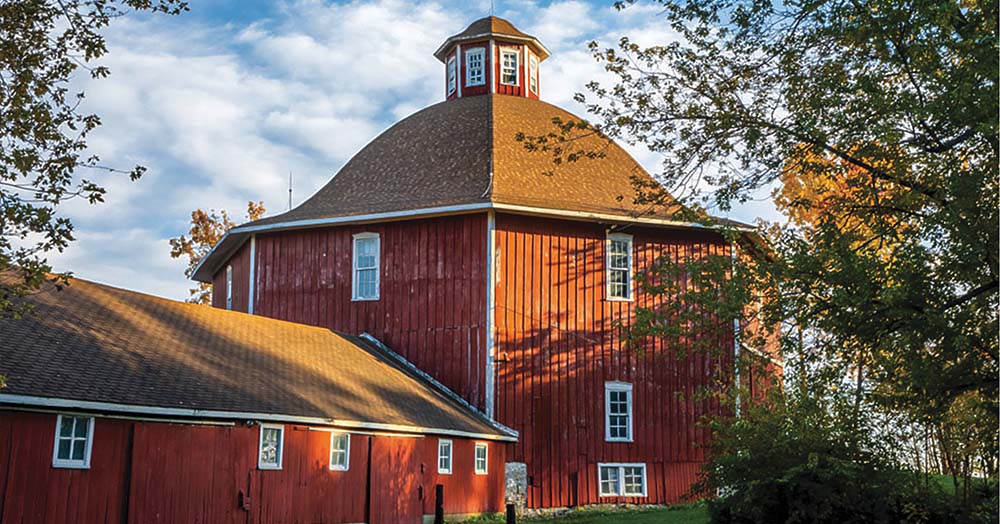 PHOTO COURTESY IOWA BARN FOUNDATION
The Secrest Octagonal Barn dates to 1883.
PHOTO COURTESY IOWA BARN FOUNDATION
The Secrest Octagonal Barn dates to 1883.
In 1883, a master carpenter aptly named George Frank Longerbeam built the barn for Joshua and Esther Secrest, prosperous farmers in Johnson County’s early days. The three-level, 75-foot-tall structure once housed 200 tons of loose hay, 32 horses, and 16 cows. The Secrests forked hay down to their horses via four shoots from the cathedral-like loft, and they carted hay along a short wooden rail line to an adjacent cattle-feeding shed.
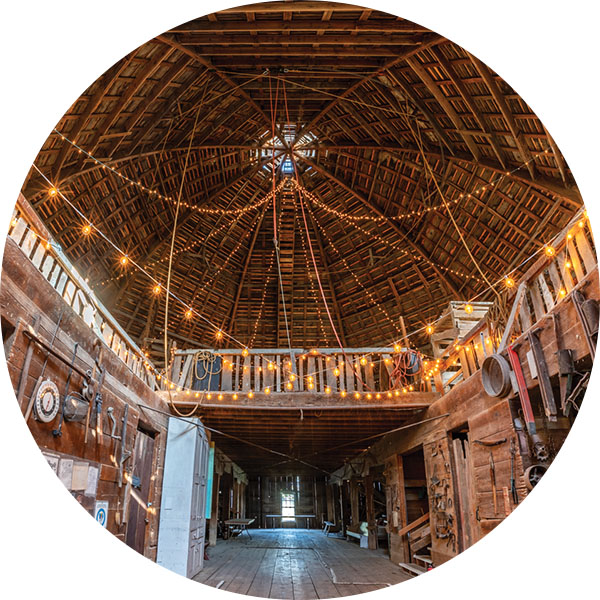 Photo Courtesy Iowa Barn Foundation
The soaring, cathedral-like hay loft is among the barn's unique architectural features.
Photo Courtesy Iowa Barn Foundation
The soaring, cathedral-like hay loft is among the barn's unique architectural features.
Although round barns weren’t necessarily rare in that era, the craftsmanship and scale of the Secrest barn set it apart. Square nails hold together the eight-sided, bell-shaped roof with laminated ribs, and an octagonal cupula crowns the building. Future U.S. President Herbert Hoover, who grew up in nearby West Branch, might have been among the schoolchildren who traveled to marvel at the structure, notes Tyler.
The fact that the barn was still standing after decades of neglect when Tyler took ownership is a testament to Longerbeam’s skill. “Where one carpenter would put in three nails, Frank would put in five,” says Tyler.
A native of Ontario, Canada, Tyler was treated for stuttering as a child, and his interest in speech and hearing disorders led him to Iowa City for graduate school in speech pathology and audiology. Tyler began his career in the United Kingdom but returned to the UI as a faculty member, where he’s spent more than 40 years treating patients and conducting research in otolaryngology and at the Wendell Johnson Speech and Hearing Center. He studied some of the earliest cochlear implants, founded the university’s tinnitus and hyperacusis clinic, and published hundreds of papers and six books. In 2023, Tyler received the Jerger Career Award for Research in Audiology from the American Academy of Audiology and recently received the University of Western Ontario Communication Sciences and Disorders Alumni of Distinction Award.
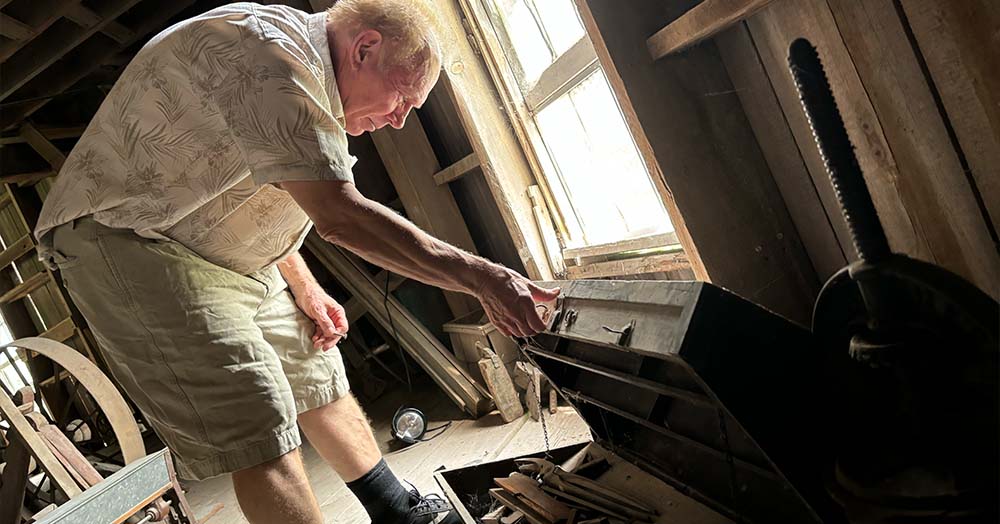 PHOTO: JOSH O'LEARY
The descendants of George Frank Longerbeam, the 19th century carpenter who built the Secrest Barn, donated his toolbox to Tyler.
PHOTO: JOSH O'LEARY
The descendants of George Frank Longerbeam, the 19th century carpenter who built the Secrest Barn, donated his toolbox to Tyler.
Tyler purchased eight acres of the former Secrest farmstead—including the barn, a farmhouse, and other outbuildings—as a place to hike and camp with his children when they were younger. It turned into a passion project. Beyond the countless weekends he’s spent chasing the raccoons away and filling the barn with antique implements and tools, Tyler has secured grants from the State Historical Society of Iowa and the Historic Preservation Alliance and coordinated hundreds of volunteers to help with restoration projects.
 PHOTO: JOSH O'LEARY
Antique tools are on display inside barn.
PHOTO: JOSH O'LEARY
Antique tools are on display inside barn.
Just this past summer, Tyler worked with an Iowa company to relocate an antique windmill to the farmstead. Tyler used an illustration of the farm from the 1880s to match the location of the original windmill to ensure its historical accuracy.
In recognition of Tyler’s efforts, the Iowa Barn Foundation, a nonprofit dedicated to preserving Iowa’s rural buildings, awarded the Secrest Barn an Award of Distinction in 2023. This past fall, the structure was one of 11 round barns featured on the foundation’s annual statewide barn tour.
“I talk with a lot of people who grew up on farms, or whose parents or grandparents were farmers, and they have stories to tell,” says Tyler, who gives presentations about the importance of agricultural preservation through Humanities Iowa. “When I give these barn talks around the state, people come up to me afterward almost crying, so it’s very motivating to save our history. I think it also helps us look to the future and decide what’s important in our lives and what we should care about.”
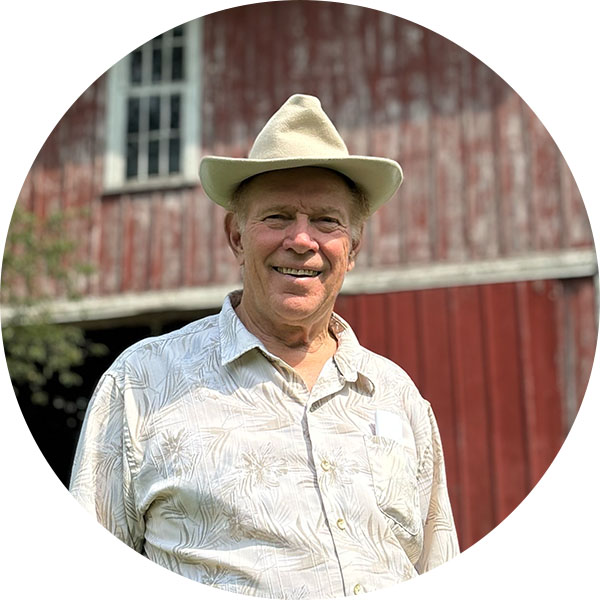 PHOTO: JOSH O'LEARY
Audiologist and UI Professor Richard Tyler gives talks around the state about Iowa's agricultural history.
PHOTO: JOSH O'LEARY
Audiologist and UI Professor Richard Tyler gives talks around the state about Iowa's agricultural history.
When Tyler first took ownership of the Secrest Barn, he wanted to host a town picnic for his new neighbors. One day, Tyler drove into Downey, the tiny unincorporated community about a mile down the road. The locals directed him to a woman in a house on the corner to ask about the party, so Tyler knocked on her door and introduced himself as the person fixing up the old octagonal barn.
“Yes, I know,” said the woman, Downey’s defacto mayor.
“What if we have a town picnic at the barn? Is that OK?” he asked.
“I’ll think about it,” the woman said.
A week later, Tyler returned to the woman’s house. “You can have the town picnic,” she said. About 50 people came out for Tyler’s first party, and he and the barn have been community fixtures ever since.
Today, Secrest Barn, which is on the National Register of Historic Places, is open to the public for tours, community events, and weddings. It hosts school field trips to teach children about farming history, and UI archaeology classes visit to dig for relics of early farm life. Each year, the barn welcomes attendees of the UI’s international tinnitus conference, which Tyler organizes, for a barbecue and square dance.
“Whenever I go and give a talk in Africa or China, people don’t ask me about my research,” he says. “They ask me, ‘How’s the round barn?’”
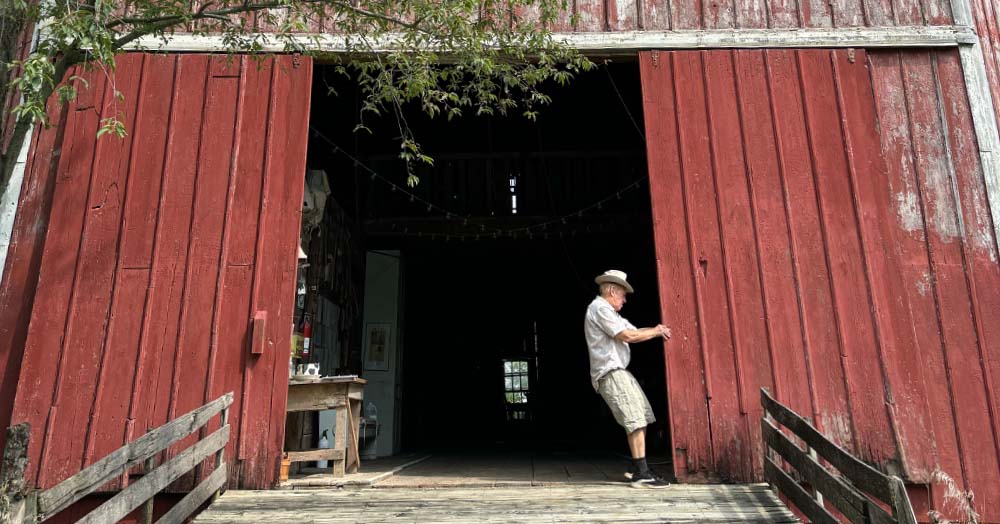 PHOTO: JOSH O'LEARY
Built in 1883 in rural Johnson County, the Secrest Octagonal Barn is listed on the National Register of Historic Places and has been recognized by the Iowa Barn Foundation for the preservation efforts of owner Richard Tyler.
PHOTO: JOSH O'LEARY
Built in 1883 in rural Johnson County, the Secrest Octagonal Barn is listed on the National Register of Historic Places and has been recognized by the Iowa Barn Foundation for the preservation efforts of owner Richard Tyler.
